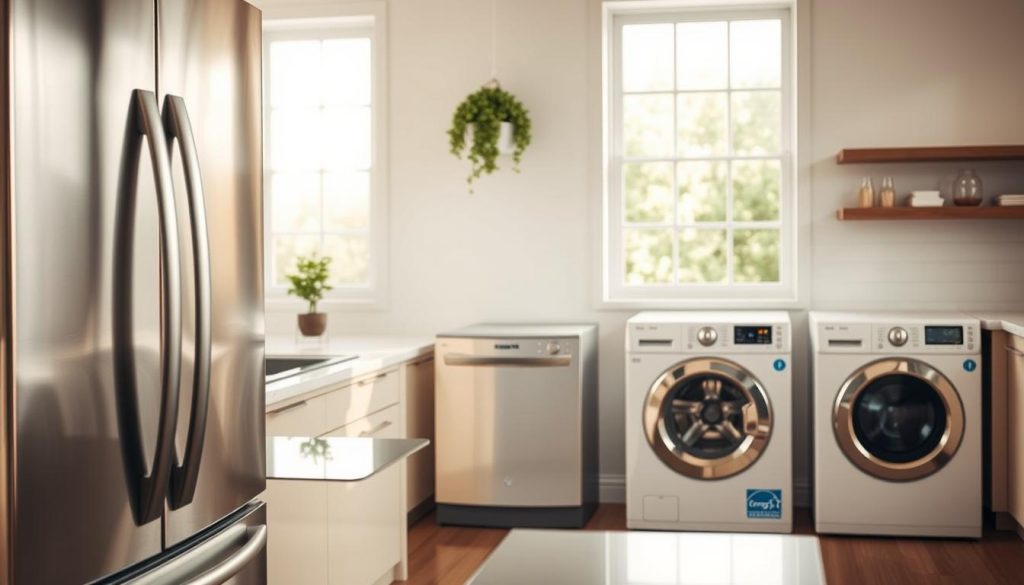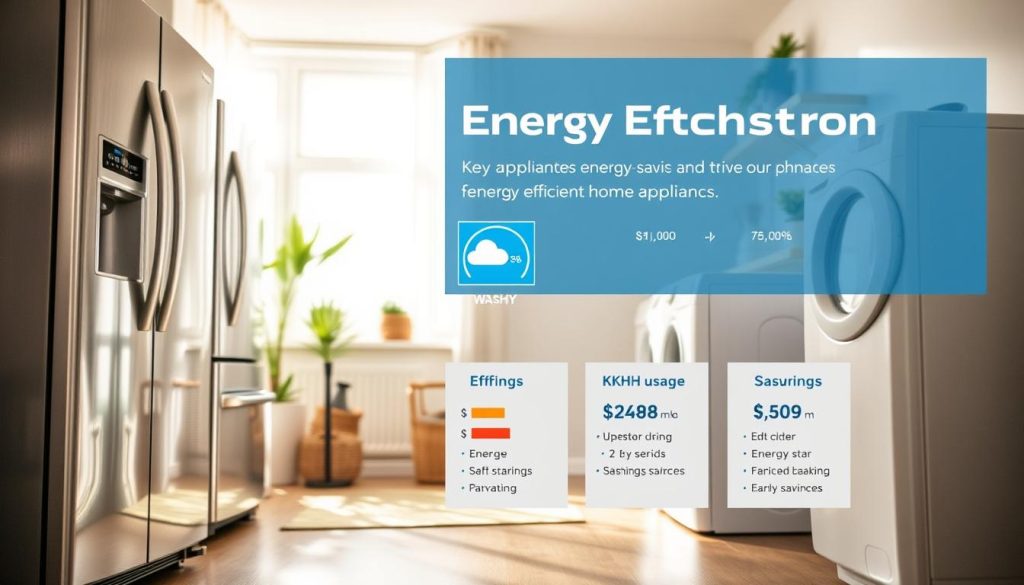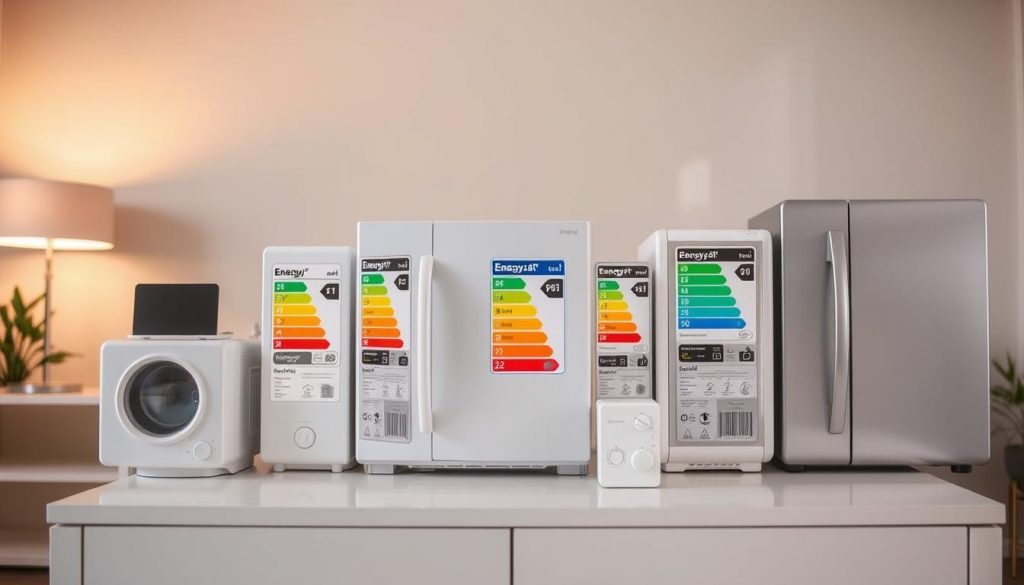How to Choose the Best Appliances and Lighting
Your Full Guide to Choose the Best Appliances and Lighting
Imagine a kitchen where everything works smoothly. The fridge hums quietly, the washer spins well, and the lights shine bright without wasting energy. It’s not just about convenience; it’s about saving money and helping the planet. Choosing the right energy-efficient appliances and lighting can seem hard. But, this guide will help you make smart choices.
By following this guide, you can cut your bills and support a greener future. It’s your roadmap to making better choices.

Every choice you make counts. This guide explains energy labels, compares top models, and shares saving tips. You’ll learn how to avoid mistakes and focus on what really matters. Whether you’re updating one appliance or redoing your whole home, this article gives you the facts you need.
Key Takeaways
- Energy-efficient appliances reduce bills and carbon footprints.
- Smart lighting and optimized refrigerators save up to 30% on energy use.
- Look for ENERGY STAR® ratings and compare kWh usage on labels.
- Modern washers with high spin speeds cut drying time and energy waste.
- LED bulbs last longer and use less power than traditional options.
Understanding Energy Efficiency in Home Appliances
Choosing energy-efficient appliances is smart for your wallet and the planet. These eco-friendly household products use less power but work just as well. They help you save money and lessen your environmental impact. Let’s explore why this is important and how it affects your home and community.

Energy-efficient appliances can cut your energy use by up to 30%. This reduces the load on your electrical system and lowers your bills. Here’s why it’s a big deal:
Why Energy Efficiency Matters for Your Home
- Lower monthly utility costs
- Prevents overworked wiring and circuits
- Keeps homes cooler in summer (less heat waste)
The Environmental Impact of Your Appliance Choices
“Replacing just one old fridge with an ENERGY STAR® model prevents 10,000 lbs of CO2 over its lifetime.”
— U.S. Environmental Protection Agency
| Impact Area | Conventional Appliances | Energy-Efficient Models |
|---|---|---|
| Annual Energy Use | 1,500 kWh | 800 kWh |
| CO2 Emissions | 1,200 lbs | 600 lbs |
Long-term Financial Benefits of Efficient Appliances
Even though they cost more upfront, saving grows over time. Here’s a comparison of savings:
| Appliance | Upfront Cost | Yearly Savings | 15-Year Savings |
|---|---|---|---|
| Refrigerator | $1,500 | $120 | $1,800 |
| Washer | $800 | $75 | $1,125 |
| Lighting | $200 | $30 | $450 |
In 10 years, a $500 more expensive ENERGY STAR® washer can save you money. Making smart choices today leads to a greener, more affordable future.
Decoding Energy Labels and Ratings
Choosing the right energy labels starts with understanding their symbols and numbers. Look for the Energy Star logo—a key energy-efficient shopping tip to identify top-rated energy-saving devices. These labels show yearly energy costs and efficiency rankings, helping compare models side by side.

- EnergyGuide labels display estimated annual costs and efficiency .
- EU ratings use A+++ to D grades for quick comparisons.
- Energy Star certified products meet strict U.S. government standards.
“Reading labels can save hundreds yearly by avoiding high-energy models,” says the U.S. Department of Energy.
When comparing refrigerators or washers, focus on kWh/year numbers. Lower numbers mean better saving chances. Check the yellow EnergyGuide tag for exact figures. Brands like LG and Whirlpool often lead in Energy Star ratings for appliances.
For lighting, LED bulbs on labels show lumens and estimated yearly costs. Skip vague terms like “energy-saving” without proof. Instead, rely on certified ratings. Prioritize models with the highest ratings in their category to maximize saving over time.
How to Choose the Most Efficient Refrigerators, Washers, and Lights
Learning energy-efficient shopping tips begins with understanding what to look for. These top saving tips help you pick appliances that save money and energy. They do this without losing performance. Focus on the metrics that really count.
Key Efficiency Metrics to Consider
| Appliance | Key Metrics |
|---|---|
| Refrigerators | Kilowatt-hours/year, volume-adjusted energy use, defrost system efficiency |
| Washer | Water usage per cycle (gallons), kWh/cycle, spin speed efficiency |
| Lights | Lumens per watt, CRI (color rendering index), lifespan hours |
Comparing Brand Performance for Energy Consumption
| Appliance | Top Brands & Models | Efficiency Stats |
|---|---|---|
| Refrigerator | LG LFXS287962, Whirlpool WRX7255DW | 350 kWh/year, 12 cu. ft efficiency |
| Washer | GE WAW7500HSS, Bosch WEE6270UC | 3.2 gal/wash, 3.5 kWh/cycle |
| Lights | Philips 913032/12, Cree LED bulbs | 90+ lm/W, 2700K-6500K color range |
Balance Between Features and Efficiency
First, focus on the essential energy-saving features. For instance:
- Refrigerators: Choose smart defrost systems over ice makers
- Washers: Front-loaders use less energy than top-loaders
- Lights: Pick dimmable LEDs that can change color
Follow these energy-efficient shopping tips to avoid spending too much on extras.
Smart Shopping for Energy-Efficient Refrigerators
Choosing the most efficient refrigerators begins with finding the right size for your home. A fridge that’s too big wastes energy, while one that’s too small means you’ll need to shop more often.
Size and Configuration Considerations
First, figure out how much fridge space you need. A family of four usually needs 18–25 cubic feet. Side-by-side models use 10–20% more energy than French door or bottom-freezer ones.
- Top/bottom-freezer: Best energy efficiency
- French door: Balances space and efficiency
- Side-by-side: Opt for only if space is limited
Technology Features That Save Energy
Look for refrigerators with variable speed compressors that adjust cooling power. They also have better insulation and humidity-controlled drawers to save energy. Door-in-door designs save 15% energy by reducing cold air loss.
Best Refrigerator Models for Energy Conservation
Here are some top models:
| Model | Annual Energy Use (kWh/year) | Annual Cost Estimate | Key Features |
|---|---|---|---|
| LG LSXS283741 | 390 | $32 | ThinSpace design, linear compressor |
| Samsung RF22T7500SR | 360 | $29 | Digital inverter compressor, Eco mode |
| Whirlpool WRF5V75HHS | 410 | $34 | Perfect Freeze tech, Smart defrost |
These energy-efficient appliances meet Energy Star standards. Use the DOE’s calculator to compare models. Also, check out reviews on Consumer Reports for real performance.
Selecting High-Efficiency Washing Machines
Choosing the right appliances is key to saving money and helping the environment. Front-loading washers save a lot of water and energy compared to top-loaders. It’s important to look at all the features to find the best balance.
Energy Star-certified models with advanced sensors are a good choice. They use less water and energy. Look for features like load-sensing technology and high-speed spin cycles. Eco cycles also help save energy without losing cleaning power.
Best green home appliances like LG’s TurboWash or Whirlpool’s EcoBoost have these features. They can really cut down your utility bills.
- Water Usage: Front-loaders average 10-20 gallons per cycle vs. 20-40 for top-loaders.
- Energy Efficiency: Models with variable-speed motors save up to 30% more electricity.
- Longevity: Bosch SilentDrive washers reduce wear on fabrics while maintaining efficiency.
High-efficiency washers need HE detergent and regular care. But, the savings on utilities make it worth it. For example, switching to an Energy Star washer can save over $110 a year.
Choose brands with strong warranties and good reviews for reliability. This way, you’ll save money and help the planet.
Save money long-term by choosing washers like the Whirlpool WTW5000DV or LG WM3988HWA. They save 30%+ on energy and clean well. Remember, investing in efficiency now means lower bills and a smaller carbon footprint later.
Illuminating Your Home: Guide to Energy-Saving Lighting Options
Choosing the right lighting can greatly affect your home’s energy use. Opting for energy-efficient appliances like LEDs or smart systems can lower your bills and help the environment. Find out how to select the best options for each room.
LED vs. CFL vs. Traditional Bulbs: Efficiency Comparison
LEDs are a better choice than older bulbs in terms of energy and lifespan. Here’s a comparison:
- LEDs: Use 75% less energy than incandescents, last 25,000+ hours
- CFLs: 75% energy savings vs. incandescents, but contain mercury
- Traditional bulbs: 90% of energy wasted as heat, short lifespan
Smart Lighting Solutions for Automated Energy Savings
Smart systems can reduce lighting energy use by up to 30%, according to the U.S. Department of Energy.
Top-rated energy-saving devices like Philips Hue or LIFX bulbs offer great benefits. They allow you to:
- Automate schedules via apps
- Use motion sensors to turn off unused lights
- Adjust brightness with daylight sensors
Choosing the Right Lighting for Every Room
Match lighting to each space:
- Kitchens: Bright 3000-5000K LEDs for task areas
- Bathrooms: Dimmable fixtures for vanity tasks
- Bedrooms: Warm 2700-3000K tones for relaxation
Outdoor areas benefit from motion-activated LED fixtures to cut nighttime saving costs.
Budget-Friendly Ways to Upgrade to Efficient Appliances
Upgrading to energy-efficient appliances doesn’t have to be expensive. These saving tips and strategies help you get the most out of rebates, timing, and financing. This way, you can save money while making your home more efficient.
“Smart timing and incentives can cut the cost of energy-efficient upgrades by up to 40%.” – U.S. Department of Energy
Available Rebates and Tax Incentives
Here are some programs to help lower the cost:
- Federal Tax Credits: You can get the Residential Energy Efficiency Tax Credit for certain appliances like HVAC systems or heat pumps.
- Utility Company Programs: Look into rebates from companies like Xcel Energy or Pacific Gas & Electric for replacing appliances.
- Manufacturer Offers: Brands like LG and Whirlpool often give instant rebates for ENERGY STAR®-certified models.
| Rebate Type | Description | Examples |
|---|---|---|
| State Programs | Regional incentives for energy upgrades | California’s Buy Clean California Act rebates |
| Manufacturer Discounts | Direct savings from appliance brands | GE’s “Efficiency Rewards” program |
| Utility Discounts | Providers giving discounts for appliance trade-ins | NRG Energy’s refrigerator recycling program |
When to Invest: Timing Your Purchases
Buying at the right time can save you even more:
- Look for energy-efficient shopping tips season sales in November–January.
- Replace appliances before they break down to avoid emergency costs.
- Take advantage of end-of-year sales, like Home Depot’s “Spring Energy Sale”.
Use Energy.gov’s calculator to see how much you can save over an appliance’s life.
Maximizing Your Savings Through Proper Appliance Usage
Even the most energy-efficient appliances need smart habits to work best. Follow these top saving tips to get the most out of your eco-friendly household products.
“Proper maintenance and usage can boost appliance efficiency by up to 30%,” states a 2023 U.S. Department of Energy study.
Begin with your fridge: keep the fresh food area between 37°F and 40°F. Clean the coils every month and check the door seals for tightness. For washing machines, always do full loads and choose cold-water cycles. High-efficiency detergents help avoid motor strain.
Lighting efficiency improves with these steps:
- Replace bulbs with LEDs—90% more efficient than incandescents.
- Install motion sensors in high-traffic areas.
- Use dimmers in living spaces to adjust brightness as needed.
Seasonal changes are important too. In summer, keep appliances away from heat. In winter, preheat ovens only when necessary. Use smart plugs or monitors to track energy use and spot wasteful habits. These small changes can make big savings over time.
The Rising Trend of Smart Appliances and Their Efficiency Benefits
Smart home technology is changing how we use energy. Today’s devices connect to apps, sensors, and networks to save energy. These energy-efficient appliances learn our habits and adjust to save power without losing performance.
How Connected Devices Save Energy
Smart appliances use data to save energy. For instance:
- Smart refrigerators adjust cooling based on door openings.
- Connected washers use the right water level for each load.
- IoT thermostats learn our schedules to save on heating and cooling.
Top Smart Appliances to Consider
Leading brands offer best green home appliances that save energy and are easy to use:
| Appliance | Model | Key Features |
|---|---|---|
| Refrigerator | LG ThinQ Smart Refrigerator | Internal cameras reduce door openings; adaptive cooling |
| Washer | Samsung SmartThings Washer | AI load sensing cuts water and energy use by 20% |
| Lighting | Philips Hue Connected Bulbs | Automatically adjusts brightness to daylight levels |
| Thermostat | Nest Learning Thermostat | Reduces HVAC energy use by learning user preferences |
These top-rated energy-saving devices can pay for themselves in 3-5 years. Make sure they work with Alexa or Google Home for easy setup.
Common Mistakes to Avoid When Shopping for Efficient Appliances
Shopping for eco-friendly household products is more than just looking for labels. Many people make big mistakes, like thinking “green” labels mean big savings. Here are some tips to steer clear of these pitfalls:
- Ignoring certification details: Terms like “eco-friendly” don’t always mean energy savings. Always check Energy Star ratings or Consumer Reports reviews.
- Prioritizing size over needs: Big appliances like huge refrigerators or washers use more energy. Choose sizes that fit your household for real savings.
- Overlooking lifetime costs: A cheaper model might cost more over time in energy bills. Use Energy.gov calculators to compare total costs.
| Mistake | Risk | Solution |
|---|---|---|
| Believing “eco-friendly” claims | False efficiency promises | Verify EnergyGuide labels |
| Ignoring installation factors | Reduced performance | Check airflow needs for HVAC units |
| Skipping rebate research | Lost savings opportunities | Use DSIRE to find local incentives |
Start saving with energy-efficient shopping tips from trusted testers. Don’t fall for marketing tricks—stick to the facts. When comparing models, look at annual energy use and warranty terms. True eco-friendly products offer both performance and savings.
Conclusion: Creating Your Energy-Efficient Home One Appliance at a Time
Creating an energy-efficient home is a step-by-step journey. Begin by swapping out old appliances for new, energy-saving ones. For example, choosing refrigerators with ENERGY STAR ratings or LED lights from Philips can cut down on energy use right away. These changes not only save money but also reduce our carbon footprint.
Focus on replacing appliances that use the most energy, like washers or HVAC systems, when you can afford it. Look for rebates and tax credits to help with the cost. Even simple changes, like switching to LED bulbs, can make a big difference over time. Smart appliances from Samsung or LG can also help by using energy more efficiently.
Every choice you make about appliances affects your home’s energy use. Choosing energy-efficient options now sets you up for future improvements. As new technologies like solar systems or AI for climate control become available, staying updated is key. Start with one change or do them all gradually. Each step you take helps save money and protects the planet. Make your journey to sustainability fit your own pace and needs, always keeping an eye on the latest options.
FAQ
What are energy-efficient appliances and why are they important?
Energy-efficient appliances use less energy but work just as well. They help cut down on energy use at home. This means lower bills and less harm to the environment.
How can I choose the most efficient refrigerators, washers, and lights?
Look for appliances with Energy Star ratings. Check their energy use and compare brands. Choose options that save energy but also meet your needs.
What are some tips for energy-efficient shopping?
Focus on products with Energy Star labels. Look for rebates and compare costs over time. Buying during sales can also save you money.
How do smart appliances contribute to energy savings?
Smart appliances use technology to save energy. They adjust settings based on how you use them. This cuts down on energy use and boosts efficiency.
What common mistakes should I avoid when buying energy-efficient appliances?
Don’t fall for claims that don’t show real savings. Choose the right size and think about long-term costs. Research brands and models well to avoid wasting money.
What are the financial benefits of investing in energy-efficient appliances?
Energy-efficient appliances cost more upfront but save money in the long run. Incentives from governments can also help with the initial cost.
How can I maximize savings through proper appliance usage?
Use appliances as recommended to save energy. Run full loads and keep temperatures right. Regular maintenance also keeps them efficient.
Are there specific brands known for energy-efficient appliances?
Yes, brands like Whirlpool, LG, Samsung, and GE are known for energy-saving devices. They offer models for all budgets that are energy efficient.




One Comment